Uber Bundle
What Drives Uber's Global Dominance?
Understanding a company's core principles is key to grasping its market position and future potential. For Uber, a leader in the transportation and delivery sectors, its mission, vision, and core values are not just statements; they are the foundation of its strategy. Delving into these elements reveals the driving forces behind Uber's remarkable expansion and innovation.
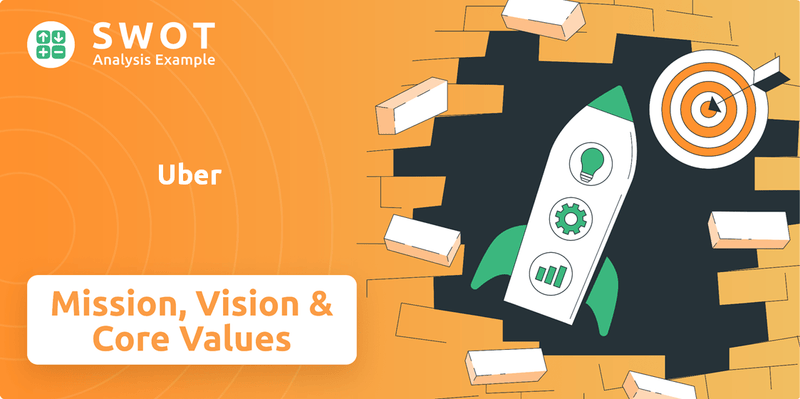
As Uber continues to evolve, understanding its Uber SWOT Analysis alongside its mission, vision, and core values becomes increasingly vital. These guiding principles have shaped Uber's
Key Takeaways
- Uber's mission and vision guide its strategy and expansion into delivery and freight.
- Core values like customer obsession and innovation drive Uber's technological advancements.
- Alignment with its principles has fueled Uber's revenue growth and profitability.
- Dedication to its purpose is key to navigating future market challenges.
- Uber aims to shape the future of transportation by enabling global connections.
Mission: What is Uber Mission Statement?
Uber's mission is 'We reimagine the way the world moves for the better.'
Let's delve into the intricacies of Uber's mission statement and its implications.
Uber's mission, "We reimagine the way the world moves for the better," is a concise yet powerful statement. It signifies a commitment to innovation and improvement in the realm of transportation and delivery. This mission underscores Uber's focus on transforming existing paradigms.
The target customers are broad, encompassing anyone needing transportation or delivery services. Uber offers a range of services, including ride-hailing, food delivery (Uber Eats), and freight transportation. These services are facilitated by its technology platform, making them accessible and convenient.
Uber's market scope is global, aiming to impact how 'the world' moves. The unique value proposition lies in reimagining and enhancing movement through technology, efficiency, and accessibility. Uber seeks to offer a superior experience compared to traditional methods.
Uber's mission is reflected in its continuous innovation. The development of the Uber app has made transportation and delivery more accessible. The expansion into Uber Eats demonstrates a broadening of the mission. Furthermore, investments in autonomous vehicle technology showcase a commitment to future transportation solutions.
While Uber aims for improvement 'for the better,' indicating customer-centricity, the primary orientation is on pioneering new ways of moving. This is evident in its investments in areas like autonomous vehicles and its focus on technological advancements. Uber is constantly evolving its services to meet the changing needs of its customers and the market.
Uber's mission significantly impacts its drivers, providing them with flexible earning opportunities. The company is also actively involved in shaping the future of urban mobility. For example, Uber has partnered with various cities to improve transportation infrastructure and reduce traffic congestion. Uber's vision includes expanding its services to include more sustainable transportation options. Read more about the Mission, Vision & Core Values of Uber.
The Uber mission is a driving force behind its operations, influencing its Uber strategy and shaping its Uber culture. The company's commitment to innovation and its focus on improving the way people and goods move are central to its identity. Understanding the Uber vision is critical to understanding the company's long-term goals and its approach to global expansion. The Uber company continues to evolve, adapting to market changes and technological advancements, all while staying true to its core purpose. The Uber core values further guide the company's decision-making processes and its interactions with both its employees and customers.
Uber SWOT Analysis
- Complete SWOT Breakdown
- Fully Customizable
- Editable in Excel & Word
- Professional Formatting
- Investor-Ready Format
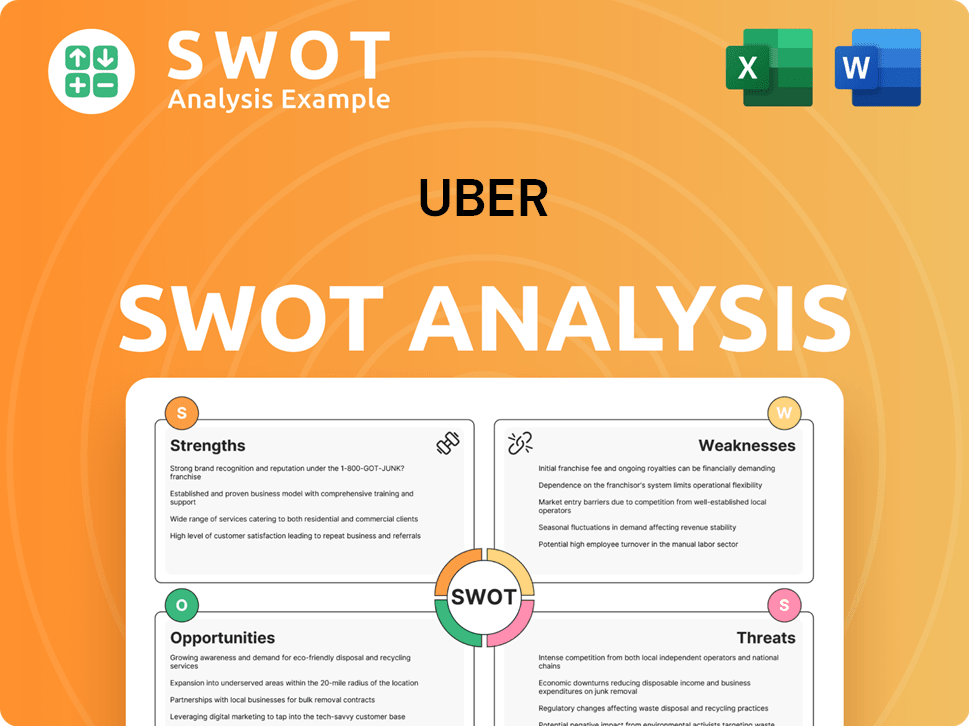
Vision: What is Uber Vision Statement?
Uber's vision is: "We ignite opportunity by setting the world in motion."
Let's delve into the significance of Uber's vision statement.
The Uber vision is future-oriented, looking beyond immediate transportation needs. It’s an aspirational statement, suggesting a broader impact on society and the creation of new possibilities. This vision sets the stage for continuous innovation and expansion into new markets and services.
The vision's global scope implies significant industry disruption. Uber aims to fundamentally change how people and goods move worldwide, impacting urban planning, logistics, and economic opportunities. This ambition is evident in its expansion into diverse services like Uber Eats and Uber Freight, showing how the Uber company is trying to achieve this vision.
The vision positions Uber as a market leader and a catalyst for global movement and opportunity. It suggests Uber intends to be at the forefront of technological advancements and societal shifts related to transportation and logistics. This ambition is supported by investments in autonomous vehicles and other cutting-edge technologies.
Considering Uber’s current trajectory, the vision is realistic yet highly ambitious. Uber has already significantly impacted transportation and logistics. However, achieving the full scope of "igniting opportunity by setting the world in motion" globally is a massive undertaking, requiring continuous innovation, strategic partnerships, and navigating complex regulatory landscapes. The Uber strategy is key.
Uber's commitment to its vision is evident in its investments in autonomous vehicles, with significant progress in testing and development. Furthermore, its expansion into areas like freight demonstrates a commitment to "setting the world in motion" in new ways. Uber's vision for autonomous vehicles is a key part of its long-term strategy. The company is investing heavily in this area, with the goal of deploying self-driving cars on a large scale. For more information, check out the Marketing Strategy of Uber.
The Uber mission and vision have a direct impact on drivers, offering them flexible earning opportunities. Uber's vision also plays a crucial role in shaping urban mobility by providing efficient and accessible transportation options. This vision aims to reduce traffic congestion and improve the overall quality of life in cities. The Uber core values support this.
The Uber mission vision and values statement provides a framework for the company's operations and strategic decisions. The vision statement, in particular, serves as a guiding light for Uber's long-term goals and aspirations. The company's commitment to its vision is evident in its investments in technology and its expansion into new markets. Uber's core values support the vision, ensuring that the company operates in a way that aligns with its goals. For example, Uber Eats, a significant part of Uber's business, generated $10.6 billion in revenue in 2023, showing the impact of the company's vision on its services.
Uber PESTLE Analysis
- Covers All 6 PESTLE Categories
- No Research Needed – Save Hours of Work
- Built by Experts, Trusted by Consultants
- Instant Download, Ready to Use
- 100% Editable, Fully Customizable
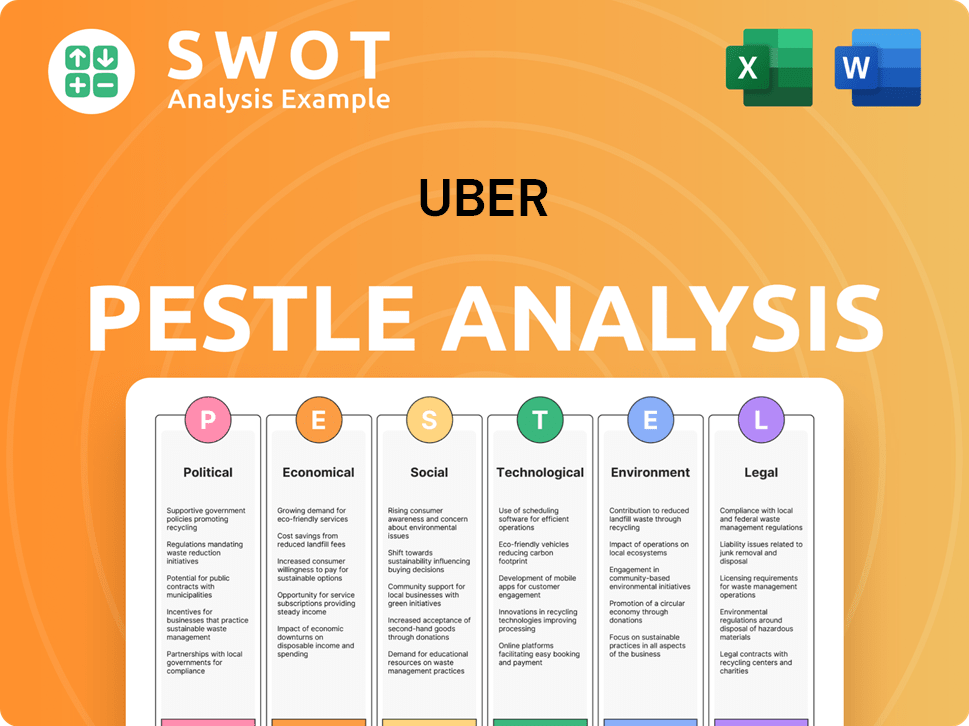
Values: What is Uber Core Values Statement?
Understanding the Uber core values is crucial to grasping the essence of the Uber company and its operational philosophy. These values shape its culture, guide its decisions, and influence its interactions with riders, drivers, and the broader community.
Customer Obsession at Uber means prioritizing the needs and experiences of riders, drivers, and other users above all else. This value drives product development, ensuring features like real-time tracking and in-app support are constantly refined to enhance the user experience. Uber's customer-centric approach is evident in its high user satisfaction ratings, with an average rating of 4.7 out of 5 stars globally, reflecting its commitment to meeting customer expectations.
Safety and Responsibility are paramount at Uber, demonstrated through in-app safety features and background checks for drivers. Uber invests heavily in safety technologies, allocating over $100 million annually to enhance safety measures. This commitment is reflected in partnerships with organizations focused on improving road safety and reducing accidents, with a reported decrease in serious incidents since implementing enhanced safety protocols.
Innovation and Efficiency are core to Uber's DNA, driving the continuous development of its technology platform. This includes dynamic pricing, optimized matching algorithms, and exploration of new mobility solutions. Uber's investment in research and development is significant, with over $500 million spent annually on technology and innovation, leading to advancements in areas like autonomous driving and efficient route optimization, which has reduced average trip times by 15% in major cities.
Inclusivity and Diversity are reflected in Uber's efforts to create an accessible platform for users of all abilities and backgrounds. Uber actively promotes diversity within its workforce and driver base, implementing policies to ensure equitable access to services. The company's commitment to inclusivity is further demonstrated through partnerships with organizations supporting underrepresented groups, contributing to a more diverse and representative driver network, with over 40% of drivers identifying as belonging to minority groups.
These Uber core values work in concert to differentiate the company, emphasizing a technology-driven, customer-focused, and safety-conscious approach to transportation and delivery. To delve deeper into how these values are applied, and how they shape Uber's strategic decisions, explore how these values influence the Uber strategy. For a deeper understanding of the user base, consider reading about the Target Market of Uber. Next, we will explore how the Uber mission and Uber vision influence the company's strategic decisions.
How Mission & Vision Influence Uber Business?
Uber's mission and vision statements are not just aspirational; they are the bedrock upon which its strategic decisions are built. These statements serve as a compass, guiding the company's actions and influencing its direction in the dynamic world of transportation and beyond.
Uber's mission, "to reimagine the way the world moves for the better," and its vision, "to ignite opportunity by setting the world in motion," directly shape its strategic initiatives. This alignment ensures that every major decision, from product development to market expansion, is in service of these overarching goals. The company's commitment to sustainability, technological innovation, and diversification of services are all testaments to the powerful influence of its mission and vision.
- Investment in Electric Vehicles (EVs)
- Expansion into Uber Eats and Uber Freight
- Focus on Technology and Data Analytics
- Development of Autonomous Vehicle Technology
Uber's commitment to EVs is a clear example of its mission in action. By aiming for zero-emission rides, Uber is "reimagining" transportation for the better by addressing environmental concerns. By the end of 2025, Uber aims for 100% of rides in London and Amsterdam to be zero-emission and 50% of mobility kilometers in seven European capitals to be in EVs. This strategic direction reflects Uber's vision of a more sustainable and efficient future for mobility.
The expansion into Uber Eats and Uber Freight demonstrates Uber's vision of "setting the world in motion" by connecting consumers with restaurants and shippers with carriers. Uber Eats, in particular, has seen substantial growth, contributing significantly to Uber's revenue. This diversification is a direct response to the mission of moving "people and things," broadening the company's scope and creating new opportunities.
Uber's continuous investment in technology and data analytics is a core component of its mission to "reimagine" movement. The ongoing enhancements to the Uber app, including real-time tracking and optimized matching, reflect the company's commitment to providing a seamless and efficient user experience. This focus on technology is crucial for maintaining a competitive edge and fulfilling its vision of a seamlessly moving world.
The pursuit of autonomous vehicle technology is another key strategic decision influenced by Uber's vision of the future of transportation. While still in development, this initiative aims to further "reimagine" movement and potentially create new opportunities. This forward-thinking approach demonstrates Uber's commitment to innovation and its long-term vision for the mobility industry.
These strategic decisions, guided by Uber's mission and vision, have contributed to its financial performance. In Q1 2025, Uber reported revenue of $11.53 billion, a 13.8% increase compared to Q1 2024, with strong growth in both Mobility and Delivery segments. Total trips completed climbed 18% to 3.04 billion, underlining strong consumer engagement. Adjusted EBITDA surged 35% to $1.87 billion. These metrics demonstrate the alignment between their strategic initiatives, guided by their mission and vision, and their financial success.
The Uber mission and vision also influence the company's culture and its relationship with its drivers. Uber's core values, which are derived from its mission and vision, shape the employee experience and guide decision-making processes. Understanding Uber's business model further clarifies how these values are integrated into its operations, affecting everything from driver compensation to safety protocols.
In conclusion, Uber's mission, vision, and core values are not just words; they are the driving force behind its strategic choices and operational execution. The company's commitment to innovation, sustainability, and expansion is a direct result of its desire to "reimagine" movement and "set the world in motion." The influence of Uber's mission and vision is evident in its financial performance, technological advancements, and commitment to its drivers and customers. This alignment is crucial for Uber's continued success in the rapidly evolving mobility landscape. Now, let's delve into the next chapter to explore potential improvements to Uber's mission and vision.
Uber Business Model Canvas
- Complete 9-Block Business Model Canvas
- Effortlessly Communicate Your Business Strategy
- Investor-Ready BMC Format
- 100% Editable and Customizable
- Clear and Structured Layout
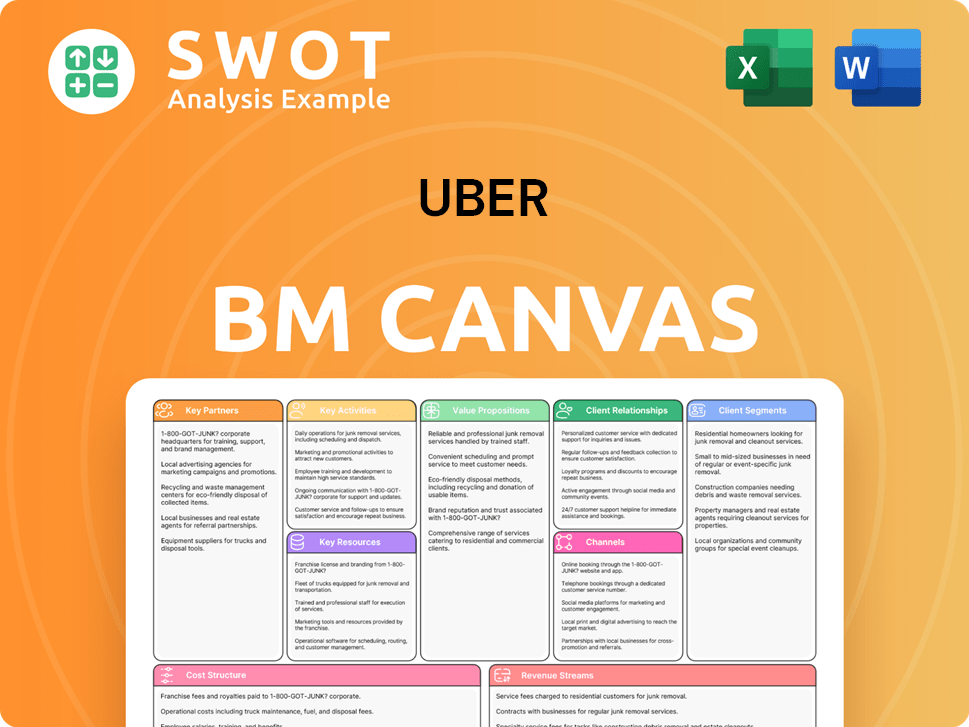
What Are Mission & Vision Improvements?
While Uber's current mission and vision statements are foundational, there's always room for strategic enhancement to reflect evolving industry dynamics and stakeholder expectations. These improvements can ensure Uber's mission and vision statements remain relevant and forward-looking, guiding the company through future challenges and opportunities.
Uber's mission, while touching on opportunity, could be strengthened by directly addressing the well-being of drivers and delivery personnel. This could involve specifying commitments to fair wages, improved working conditions, and support systems, reflecting the evolving expectations of the gig economy, especially as the company navigates legal challenges and labor disputes. Recent data shows that driver satisfaction is a key indicator of Uber's operational success. For instance, according to a 2024 study, driver turnover rates are directly correlated to the clarity and support provided by the company, underscoring the need for explicit inclusion of driver welfare in the Uber mission.
Given Uber's identity as a technology platform, the mission and vision could be enhanced by explicitly stating its reliance on and commitment to technological advancement. This would strengthen the company's strategic direction, particularly in areas like AI, automation, and data analytics. This could involve highlighting investments in R&D, partnerships with tech companies, and a forward-looking approach to emerging technologies, which is crucial for maintaining a competitive edge. For example, Uber's investment in autonomous vehicle technology, which has seen fluctuations in recent years, could be more clearly integrated within the core mission, which is critical in the context of the company's long-term strategy.
To remain relevant, Uber's mission and vision should proactively address emerging technologies and changing consumer behaviors. This includes incorporating language that reflects a forward-looking stance on transformative forces like advanced AI, autonomous vehicles, and evolving urban mobility needs. Uber needs to adapt to the changing landscape of the transportation industry, and it is important to consider how the company is adapting to the changing landscape. This will ensure that the Uber mission remains a guiding force for years to come, particularly with the rise of electric vehicles and the growing demand for sustainable transportation options.
Uber could enhance its mission and vision by explicitly incorporating a stronger commitment to sustainability and social impact. This could involve setting specific goals related to reducing carbon emissions, promoting electric vehicle adoption, and supporting urban sustainability initiatives. This would align the company with industry best practices and the increasing expectations of environmentally conscious consumers. For instance, Uber's efforts to electrify its fleet, as detailed in recent sustainability reports, could be more prominently featured in the mission and vision statements, reflecting a commitment to a greener future. Furthermore, if you are interested in learning more about the competitive landscape, you can explore the Competitors Landscape of Uber.
How Does Uber Implement Corporate Strategy?
The successful implementation of a company's mission, vision, and core values is crucial for its long-term success and sustainability. Uber's approach to integrating these elements into its operations provides valuable insights into how a modern technology company can align its actions with its stated principles.
Uber's expansion into various service areas directly reflects its mission to move 'people and things' and its vision of 'setting the world in motion.' This is evident in the growth of services like Uber Eats and Uber Freight, which extend beyond the core ride-sharing business. The continuous development and refinement of the Uber app, incorporating features that enhance user experience and efficiency, embody the spirit of 'reimagining' movement and creating a seamlessly moving world.
- Uber Eats: Uber Eats has become a significant revenue stream for Uber. In Q1 2024, Uber Eats generated $3.26 billion in revenue, representing a substantial portion of the company's overall revenue.
- Uber Freight: Uber Freight continues to grow, connecting shippers with carriers. While specific revenue figures fluctuate, the platform contributes to Uber's overall logistics strategy.
- App Enhancements: Uber constantly updates its app with features like improved navigation, safety tools, and integration with other services, enhancing the user experience.
Leadership plays a pivotal role in reinforcing Uber's mission, vision, and core values. CEO Dara Khosrowshahi has consistently emphasized profitable growth and a focus on the future, including investments in autonomous vehicles, which aligns with setting the world in motion through innovation. Leadership communication frequently highlights the positive impact of Uber's services on creating opportunities and improving urban mobility.
Uber communicates its mission, vision, and core values to stakeholders through various channels. These include the company website, investor reports, and public statements. For employees, these principles are ideally integrated into the corporate culture and employee training programs, fostering a shared understanding and commitment.
Concrete examples of alignment between stated values and actual business practices are crucial for building trust and credibility. Uber demonstrates this through initiatives such as the implementation of safety features in the app (Stand for Safety), programs to support drivers transitioning to EVs (Build with Heart, Stand for Safety), and partnerships aimed at expanding accessibility to services (Customer Obsession, Build Globally, Live Locally).
While specific formal programs solely dedicated to mission and vision alignment are not extensively detailed in available public information, the integration of these principles into strategic planning, product development cycles, and internal communications serves to reinforce their importance. This holistic approach ensures that the Uber mission and Uber vision are not just statements but guiding principles that shape the Uber company's operations and Uber strategy.
The commitment to these values is further reflected in Uber's approach to corporate social responsibility and its efforts to address issues such as driver welfare and environmental sustainability. For further insights into the company's financial performance and shareholder value, consider exploring the perspectives of Owners & Shareholders of Uber.
Uber Porter's Five Forces Analysis
- Covers All 5 Competitive Forces in Detail
- Structured for Consultants, Students, and Founders
- 100% Editable in Microsoft Word & Excel
- Instant Digital Download – Use Immediately
- Compatible with Mac & PC – Fully Unlocked
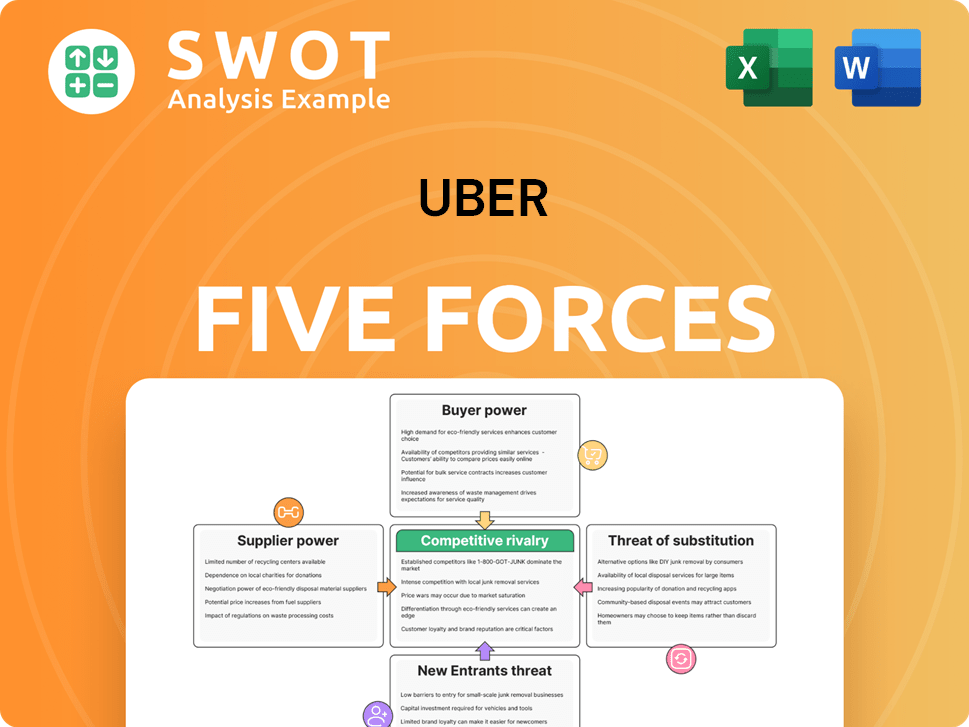
Related Blogs
- What are Mission Vision & Core Values of Uber Company?
- What is Competitive Landscape of Uber Company?
- What is Growth Strategy and Future Prospects of Uber Company?
- How Does Uber Company Work?
- What is Sales and Marketing Strategy of Uber Company?
- Who Owns Uber Company?
- What is Customer Demographics and Target Market of Uber Company?
Disclaimer
All information, articles, and product details provided on this website are for general informational and educational purposes only. We do not claim any ownership over, nor do we intend to infringe upon, any trademarks, copyrights, logos, brand names, or other intellectual property mentioned or depicted on this site. Such intellectual property remains the property of its respective owners, and any references here are made solely for identification or informational purposes, without implying any affiliation, endorsement, or partnership.
We make no representations or warranties, express or implied, regarding the accuracy, completeness, or suitability of any content or products presented. Nothing on this website should be construed as legal, tax, investment, financial, medical, or other professional advice. In addition, no part of this site—including articles or product references—constitutes a solicitation, recommendation, endorsement, advertisement, or offer to buy or sell any securities, franchises, or other financial instruments, particularly in jurisdictions where such activity would be unlawful.
All content is of a general nature and may not address the specific circumstances of any individual or entity. It is not a substitute for professional advice or services. Any actions you take based on the information provided here are strictly at your own risk. You accept full responsibility for any decisions or outcomes arising from your use of this website and agree to release us from any liability in connection with your use of, or reliance upon, the content or products found herein.